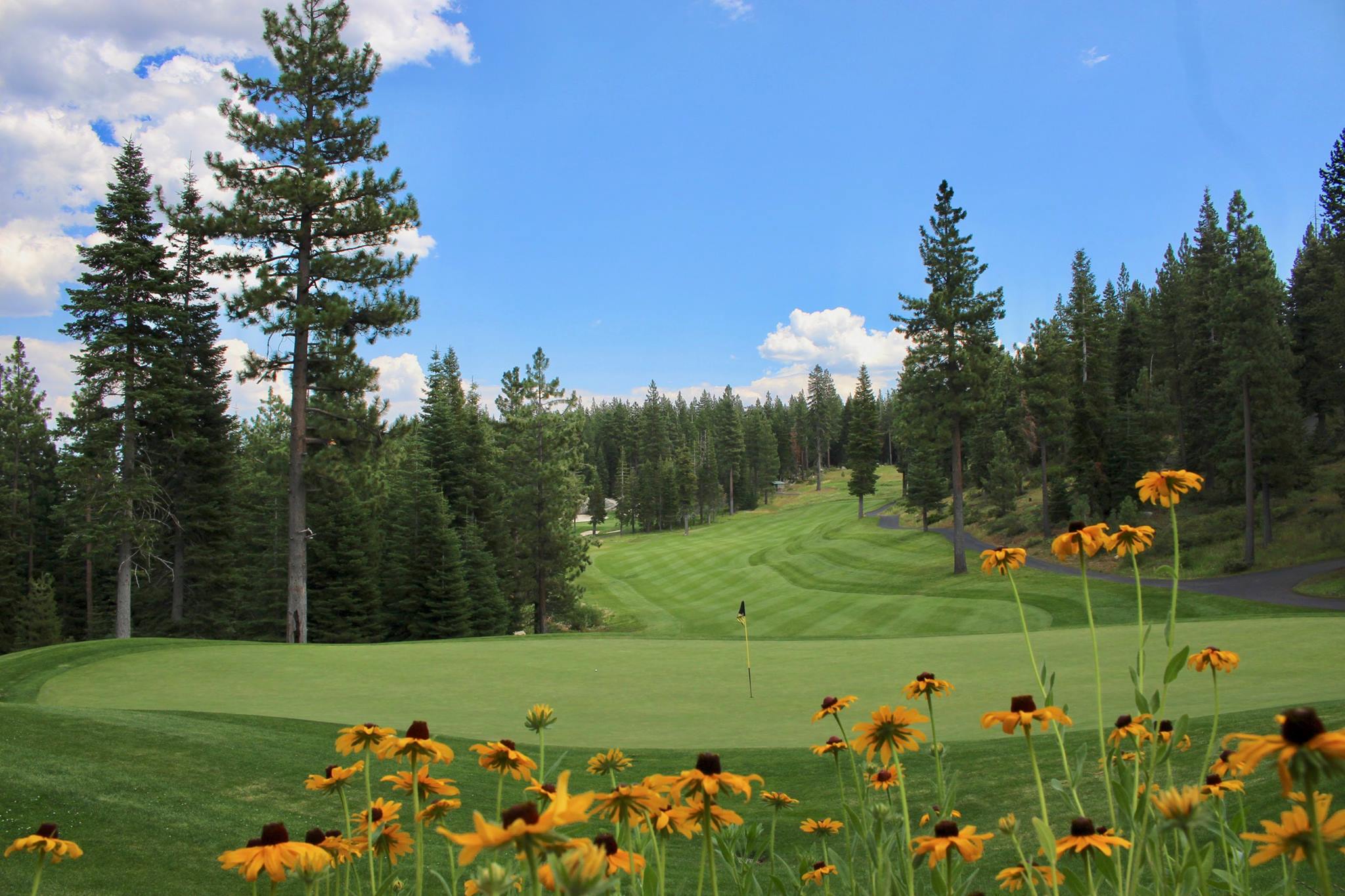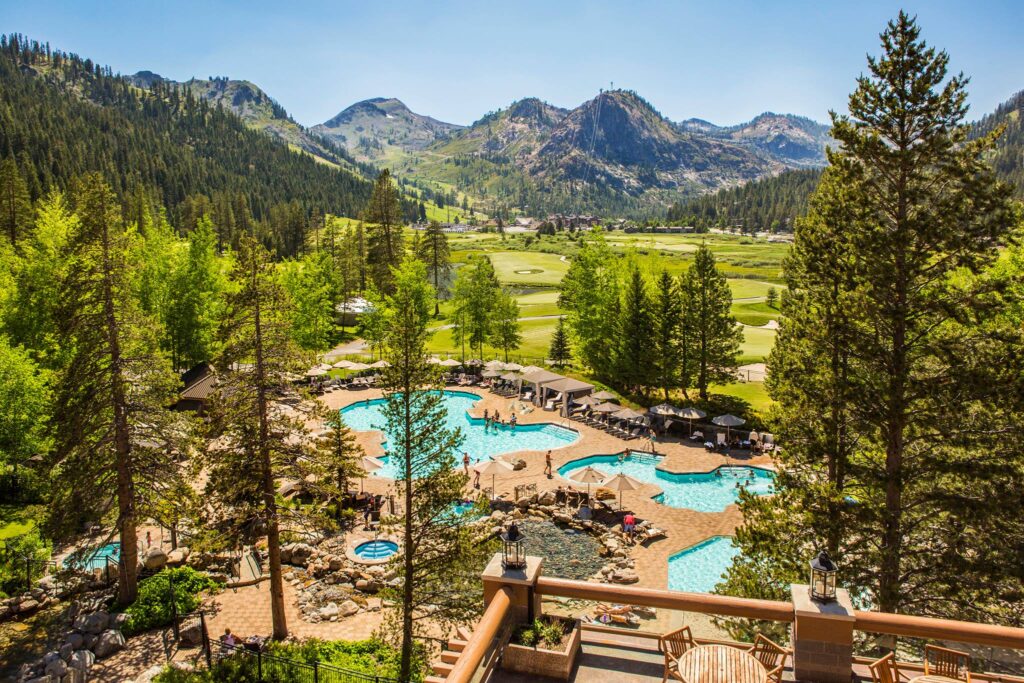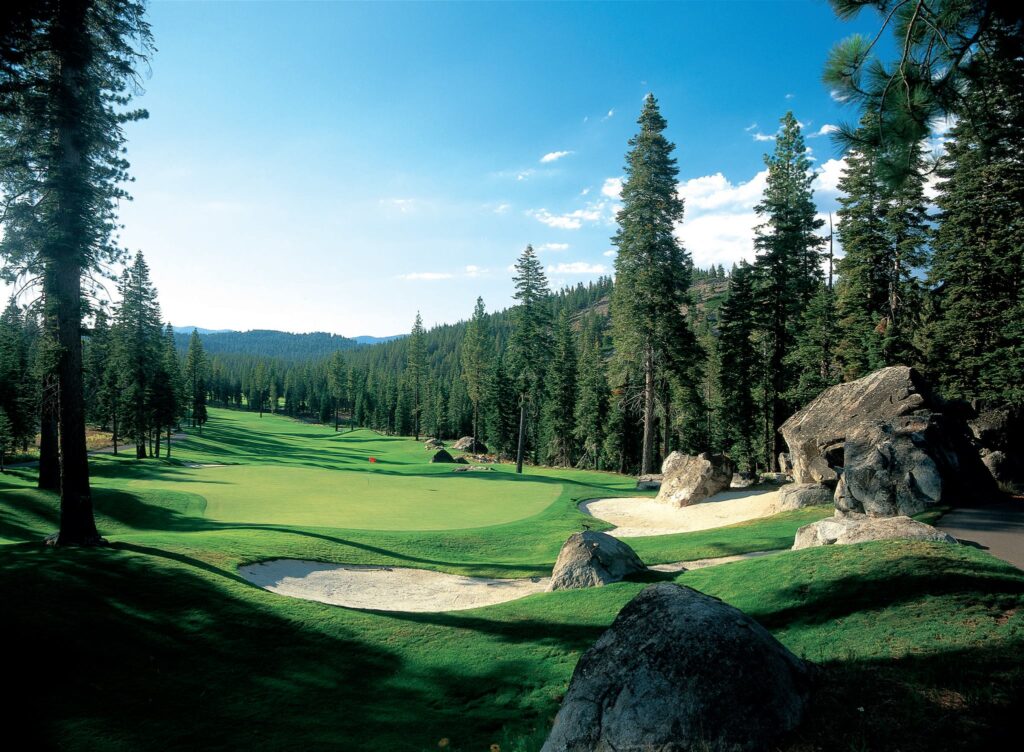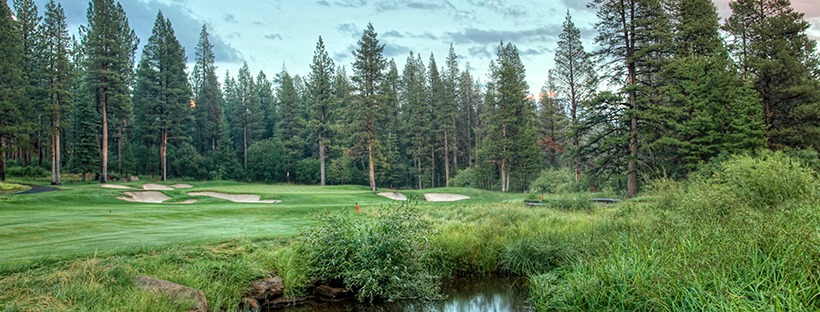
Coyote Moon Golf Course
Part of the appeal of golf is the chance to enjoy nature, escape the rat race (even for just a few hours) and revel in the one-on-one challenges of the game.
One of the nation’s great places to “get away from it all” for golf is in Truckee, in the northern Sierra Nevada mountains of California near the northwest edge of sublime Lake Tahoe, North America’s largest alpine lake.
Three courses here, Coyote Moon Golf Course and Tahoe Donner Golf Course in Truckee and The Links at Everline in Olympic Valley offer a wonderful combination of sublime golf, serenity and serious “wow” factors.

The Links at Everline
Coyote Moon flies under the radar
It’s easy to think there’s nothing else going on in the world but the fairways and greens ahead when playing Coyote Moon, situated just northwest of Truckee’s main street. Built on a site replete with rolling hills and rocky outcroppings, lined by tall pines and accentuated by Trout Creek as it forks into the Truckee River, Coyote Moon is as isolated as it gets.
Designed by former PGA and European Tour player, Brad Bell, and opened in 2000, Coyote Moon seems worlds apart from civilization. The course sits on 250 acres of secluded up-and-down terrain without a house in sight.
Bell fully utilized the natural setting while employing at many junctures the snowcapped Sierra Nevadas as a stunning backdrop. Grass mounds enhance each hole and native tall grasses and wildflowers are scattered throughout; it’s not unusual to see deer, hawks and coyotes during a round here.
Coyote Moon is a par-72 and 7,177 yards from its back set of four tees. Even though it sits at an elevation of about 5,700 feet, the course is difficult (at least until one really knows the lay of the land) because of its terrain and many elevated greens.
Despite having six par-4s of 430 yards or more, Coyote Moon does not demand length as much as it asks for a great all-around game. Six of its top seven holes by handicap are two-shotters, including one that’s really long (the 472-yard 17th) and another relatively short (404-yard fifth).
Try to take advantage of the opportunities at the 527-yard par-5 seventh, as the green can be reached with two solid strokes, and the 173-yard par-3 eighth, which can be attacked but also must not be taken for granted. The 519-yard par-5 12th offers another chance to gain a shot or two on par but take plenty of club on the approach which plays up to a green ringed by outcroppings.
If there’s a signature hole at Coyote Moon, it’s likely the 227-yard, par-3 13th, which drops some 200 feet from tee to green to an all-or-nothing putting surface bordering the creek.
The final two holes illustrate Coyote Moon’s penchant for taking something away and giving it right back. The 17th plays a little shorter because of its raised tee, but the landing area is narrowed by a large pine at the left. The putting surface is tiered and exposed to the wind, making precision here vital.
The closer stretches just 341 yards, but the fairway ends at about 230 yards and the three-tiered green perches in the shadow of the clubhouse.
Coyote Moon is a jewel in the High Sierras, praised by those who’ve played it and virtually unheard of among those who haven’t. It’s consistently rated as one of the top courses in the western U.S. and has been ranked by Golfweek magazine as the 15th best course in California.
Golfers enjoy Coyote Moon because it offers mountain golf with large doses of forgiveness. Each hole is different and the views alone are worth the trip, even if you aren’t playing golf. But where’s the fun in that?

Coyote Moon
Accuracy a must at Tahoe Donner Golf Course
Tahoe Donner Golf Course is located about two miles north of the massive memorial erected in tribute to the Donner Party (which suffered a horrendous fate in the winter of 1846-47) and the spirit of the American West. The layout is situated on 200 acres and features plenty of elevation changes amid granite outcroppings. The course is renowned for having some of the Tahoe Region’s best putting surfaces.
Opened in 1976, the front nine was built and designed by Roy Williams and then expanded to 18 holes and refined by famed architect, Billy Bell Jr. The first director of golf at Tahoe Donner was Craig Stadler, former PGA and current Champions Tour player. Photographs in the lodge capture one of the facility’s most memorable days when Jack Nicklaus, Tom Watson and Stadler competed in a golf exhibition.
The track is carded at a par of 72 and stretches 7,002 yards from its back set of four tees and underwent a major renovation in 2006 and again in 2020 and garnered a Golf Digest nomination for “Best Remodeled Course in America.”
Set amid the natural splendor of forest and streams, the course asks golfers to negotiate a considerable number of doglegs as well as multi-tiered greens with plenty of roll and movement. The layout wanders through pine forests interlaced with meandering creeks and streams. From the peaks of its rolling hills visitors can enjoy panoramic views of the Truckee Valley.
Tahoe Donner Golf Course has seven par-4s of 410 yards or more. But the need for driving prowess is mitigated somewhat by the elevation (about 7,200 feet above sea level), making accuracy a must to keep shots in play amidst the corridors.
The challenge begins at the opener – an incredibly tight, 452-yard par-4 that is arguably the most difficult starting hole in the Sierra Nevada. The ascending route requires a drive placed along the left side of a tight fairway to provide a decent angle into the green.
Perhaps the most demanding stretch at Tahoe Donner is its midsection. The 468-yard par-4 eighth is ranked the No. 3 hole by handicap (after the first). It’s followed by the 574-yard par-5 ninth and 421-yard par-4 10th.
Players can take a chance at driving the green at the 321-yard par-4 13th, but the prudent play is to find the fairway for a safer wedge approach.
After putting out on the 17th, golfers take a 300-yard walk or ride through a forest before reaching the closer, which may be the best test at Tahoe Donner. Starting off a towering tee and dropping to the deepest green complex on the course, the hole measures 417 yards from the tips and provides a spectacular end to the round. The putting surface is the largest on the course and surrounded by five bunkers fronted by Trout Creek.
Although Tahoe Donner GC shares a name and a location with the ill-fated pioneering party, this course is all about feast, not famine, catering a heaping helping of all the assets that are good about golf in the region.

Tahoe Donner Golf Course
The Links at Everline boasts a winning combination of mountains & wetlands
The Links at Everline (formerly known as The Championship Course at Squaw Creek) is the main spring and summer draw at the recently rebranded Everline Resort & Spa, which occupies the site of most of the events from the 1960 Winter Olympics in Squaw Valley.
The Olympics were held Feb. 18-28. Squaw Valley was an undeveloped resort when the Games were awarded in 1955 so from 1956-60 the entire infrastructure and all the venues were built at a cost of more than $80 million, the equivalent of almost a billion dollars today.
The Olympic Village was designed to be intimate, allowing spectators and competitors to walk to nearly all the sporting venues. Squaw Valley hosted athletes from 30 nations who competed in four sports and 27 events; women’s speed skating and the biathlon made their Olympic debuts here.
Located at the base of the resort’s ski mountain at an elevation of 6,200 feet, The Links at Everline is a par-71 layout that measures 6,931 yards from the back tees.
When the golf course was designed in the mid-1980s by Robert Trent Jones Jr., it was heralded as one of the industry’s top environmental success stories. Jones melded the mountain surroundings (and a handful of holes that run next to and through massive rocks) with the natural wetlands formed in the lowlands between the ridges.
The course is maintained without the use of chemical pesticides, a boon for the native wildflowers, birds and animals that find sanctuary here. Crossing mountain and meadow terrain, the layout is made difficult by its narrow fairways — not from trees so much as bordering wetlands containing tall grasses.
The Links at Everline begins with three holes in the forest and alongside the mountain. Most notable among the openers are the 242-yard par-3 third and 554-yard par-5 fifth, which places tremendous demands on accuracy. After that, the course moves down into meadowlands, resulting in target golf.
The 386-yard par-4 sixth has a ridge running through the middle of the green that will make putting difficult if one isn’t on the correct section. At just 365 yards, the eighth continues the trend of shorter par-4s. But the meadow surrounding all sides of the hole is a factor on both the drive and second shot.
The 16th is perhaps the most visually intimidating hole here, with its green and surrounds an island in the middle of wetlands and high grass. At 204 yards, this par-3 isn’t the longest one-shotter but is the toughest.
For serious players, this narrow Lake Tahoe-area course is best played when the golfer is on his or her game. Precision, not distance, is the key. The four tees allow for flexibility, and the magnificent area, surrounded by six awe-inspiring Sierra Nevada peaks, is worth the trip all by itself.

The Links at Everline

